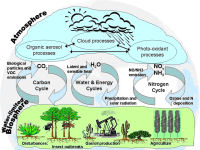BIOGENICE - Characterisation and Modelling of Climatically Relevant Primary Biogenic Ice Nuclei in the BEACHON Southern Rocky Mountain Project
Introduction

BIOGENICE is a NERC-funded project led by Prof. Martin Gallagher at the University of Manchester. BIOGENICE is participating in the US BEACHON (Biosphere-atmosphere Exchange of Aerosols within Cloud, Carbon and Hydrologic cycles, including Organics & Nitrogen) programme which is focusing in the Southern Rocky Mountain (SRM) study region in the USA.
The US study led by NCAR in collaboration with several US Universities including Colorado State University (CSU), is investigating biogenic cloud-precipitation feedback processes within a variety of distinct ecosystems within the drought affected SRM study area. A recent study suggests that the Earth’s changing climate has led to significant reduced water availability in the Western U.S. during the last half century, a trend expected to continue (Barnett et al., 2008) with repercussions for expanding populations in that region. BEACHON therefore also incorporates novel drought enhancement and remediation experiments investigating techniques to manage ecosystem response to climate change.
The working hypothesis of BEACHON is that emission of biogenic aerosols over the region has a significant seasonal influence on precipitation patterns in the region. Understanding the role of trace gas emissions from natural ecosystems in controlling the formation and growth of secondary organic aerosols (SOAs) and of the emissions of primary biological particles, and their subsequent impacts, via cloud activation and ice nucleation properties, on the hydrological cycle in the Western U.S. is now assuming greater importance given the increasing water demands of rapidly growing populations. These demands are being repeated in other regions of the world so the study has global relevance.
BEACHON Objectives
The key BEACHON objectives to which BIOGENICE will contribute are:
To determine the extent to which biogenic ice nuclei are generated in the Southern Rocky Mountain study region, distinguishing where possible between primary and secondary biogenic particles.
Characterize the size-dependent cloud condensation nuclei activity of these particles, differentiating between pure secondary organic aerosol and mixed particles.
Determine the extent to which higher or lower precipitation regimes, and new particle formation, impact ice nuclei and CCN concentrations.
BIOGENICE will collaborate with BEACHON by 1) contributing instrumentation to investigate primary biological particle emissions and 2) model the potential contribution of these primary biological particles as ice and giant condensation forming nuclei in the study region and their long-term influences on regional climate.

Objectives of BIOGENICE contribution to BEACHON

1. Field Measurements: In Year 1 (2011) our objective is to contribute key measurements to the BEACHON Intensive Biogenic Aerosol & IN Characterisation Studies which will be conducted at the Manitou National Park Forest near Colorado Springs. These studies will focus on measurements of the primary biological aerosol (PBAP) number size distribution fraction and micrometeorological flux measurements at the Manitou Forest Observatory, Colorado, USA.

2. Modelling & Data Exploitation. In Year 2 (2012) BIOGENICE will (i) Undertake analysis, synthesis and interpretation of the PBAP and micrometeorological data sets; (ii) Contribute data to the BEACHON database to aid development and testing of PBAP emission parameterisation schemes for the SRM study region. (iii) Conduct cloud model sensitivity studies using the ACPIM explicit cloud microphysics model developed as p[art of the APPRAISE programme to investigate those cloud processes that are potentially most susceptible to biogenic IN.
Measurement activities will build on expertise gained in previous forest ecosystem exchange experiments including FORESTNOX (Temperate Northern European forests) and ACES (Tropical Rain Forests). A novel new single particle bio-fluroescence aerosol spectrometer is being constructed by co-worker Professor Paul Kaye at the University of Hertfordshire specifically for BIOGENICE, and additional instrumentation will be contributed by Dr. Virginia Foot from DSTL. These will allow real-time monitoring of fluorescent primary biological particles below and above the Manitou forest canopy. Combined with high resolution turbulence measurements a detailed diurnal picture of primary biological particle production and transport within and out of the forest canopy will be built up.

References
Barnett, T.P., D.W. Pierce, H.G. Hidalgo, C. Bonfils, B.D. Santer, T. Das, G. Bala, A.W. Wood, T. Nozawa, A.A. Mirin, D.R. Cayan, and M.D. Dettinger, Human-induced changes in the hydrology of the western United States, Science, 319, 1080-1083, 2008.
A. M. Gabey, M. W. Gallagher, J. Whitehead, J. R. Dorsey, P. H. Kaye, and W. R. Stanley. Measurements and comparison of primary biological aerosol above and below a tropical forest canopy using a dual channel fluorescence spectrometer. Atmos. Chem. Phys., 10, 4453–4466, 2010. www.atmos-chem-phys.net/10/4453/2010/
Kaye, P. H., Stanley, W. R., and Hirst, E.: Single particle multichannel bio-aerosol fluorescence sensor, Opt. Express, 13, 3583– 3593, 2005.
Kaye, P. H., Aptowicz, K., Chang, R. K., Foot, V., and Videen, G.: Angularly Resolved Elastic Scattering from Airborne Particles, Opt. Biol. Part., 31–61, 2007.
J. D. Whitehead, M. W. Gallagher, J. R. Dorsey, N. Robinson, A. M. Gabey, H. Coe, G. McFiggans, M. J.Flynn, J. Ryder, E. Nemitz, and F. Davies. Aerosol fluxes and dynamics within and above a tropical rainforest in South-East Asia. Atmos. Chem. Phys., Accepted, 2010. See APC Discussion paper, http://www.atmos-chem-phys-discuss.net/10/12023/2010/acpd-10-12023 2010.html.
